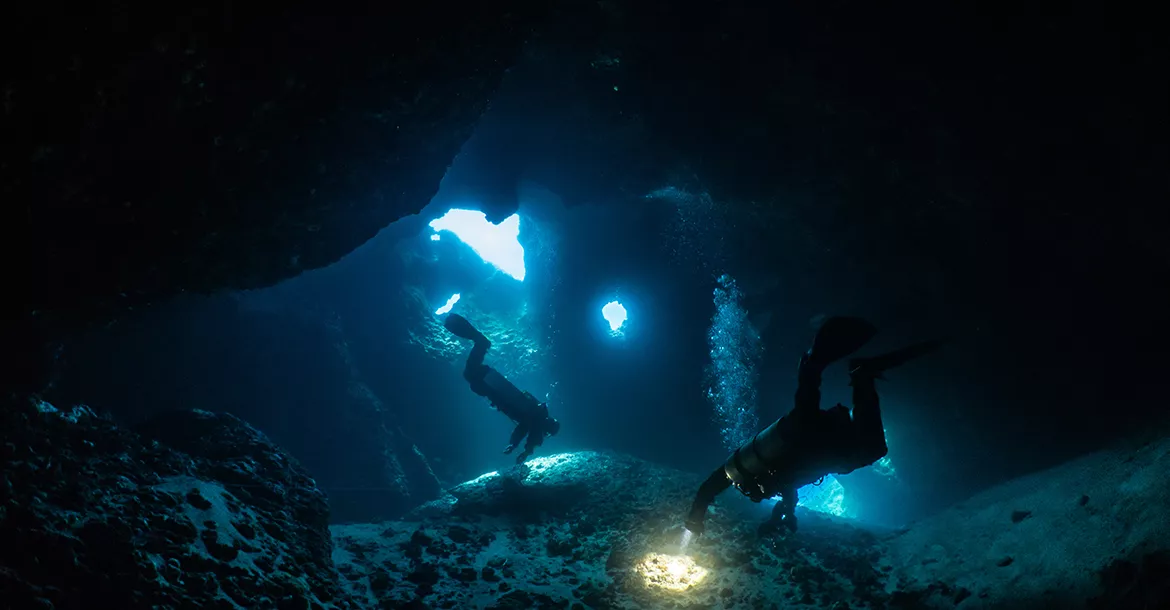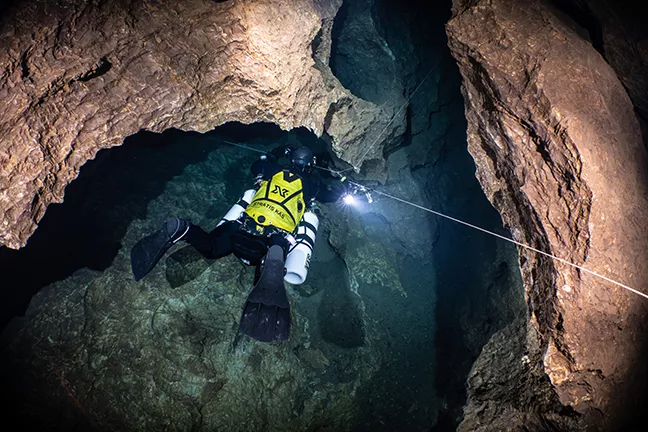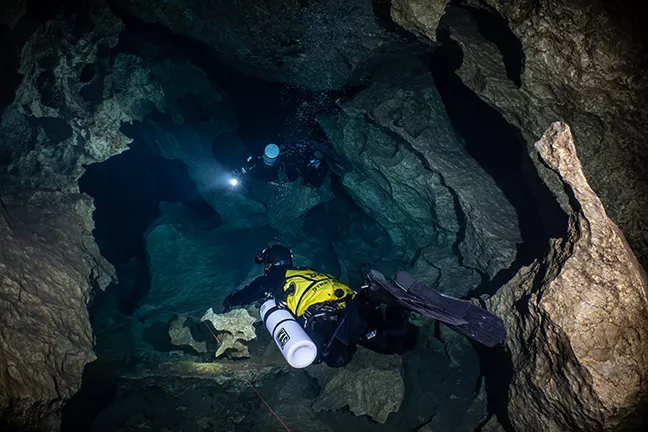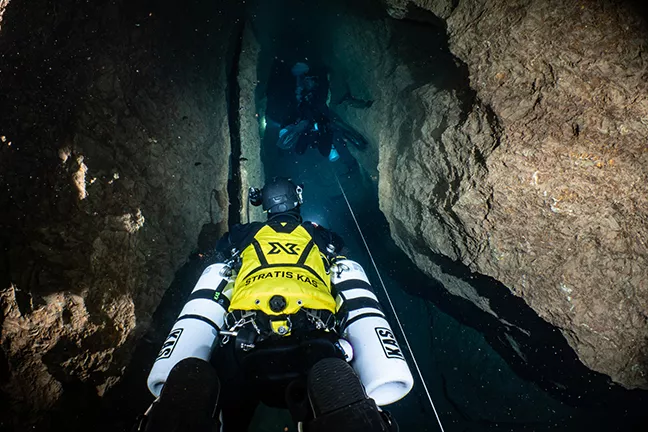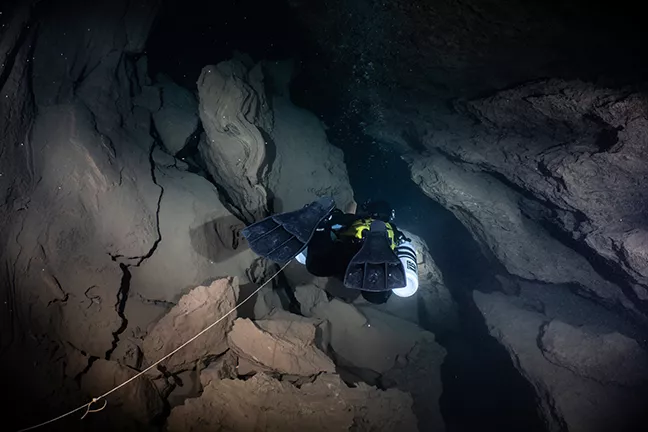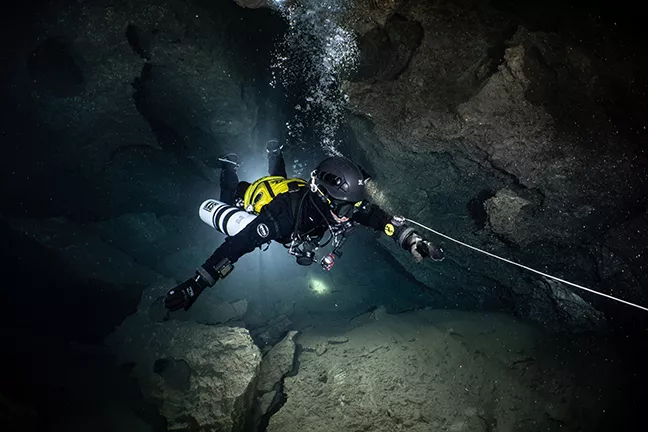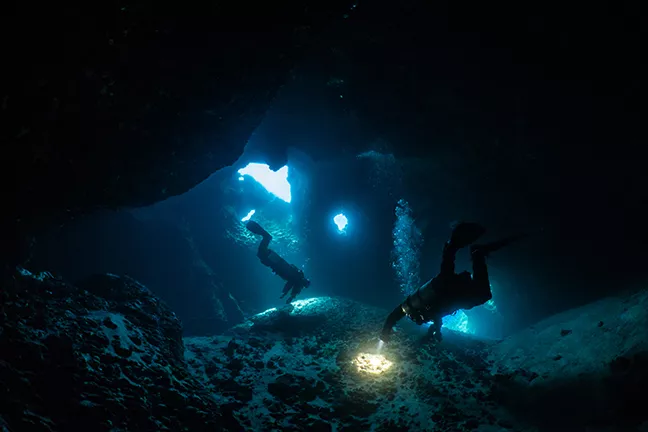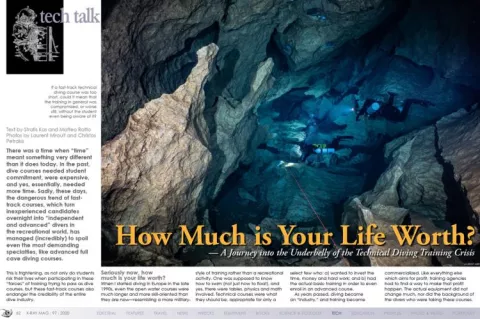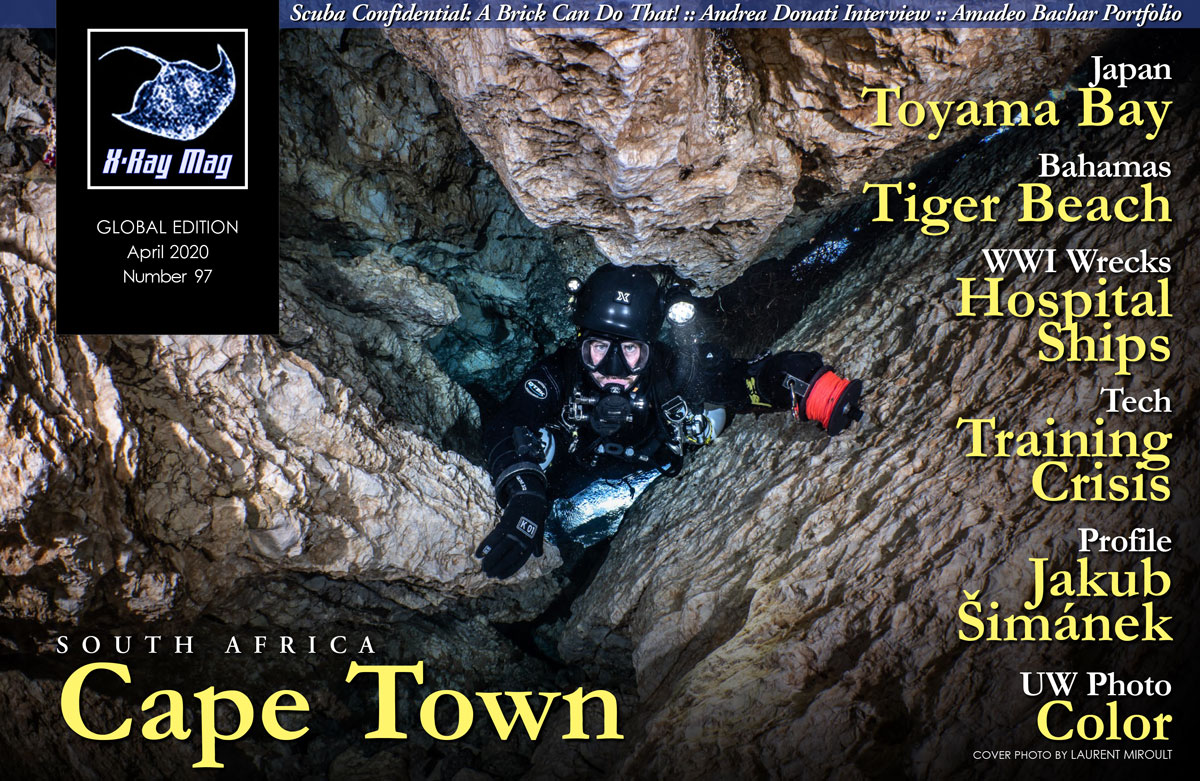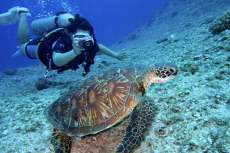There was a time, when “time” meant something very different than it does today. In the past, dive courses needed student commitment, were expensive, and yes, essentially, needed more time. Sadly, these days, the dangerous trend of fast-track courses, which turn inexperienced candidates overnight into “independent and advanced” divers in the recreational world, has managed (incredibly) to spoil even the most demanding specialties, like advanced full cave diving courses.
Contributed by
Factfile
Stratis Kas is a professional award-winning photographer, filmmaker, trimix, cave and DPV instructor and is the co-author of cave diving manuals, exams and related materials. Widely published in international magazines like Vogue (Italy, Russia, Greece) and GQ (UK), his images have been exhibited in London, New York and Paris, and have been used by brands such Christian Dior and Levi’s. Diving since 2001, Kas has truly global experience in diving, from South America to Hawaii, from high-altitude lakes and Florida caves in the United States to the Red Sea and beyond. Since 2016, Kas has led the Top2bottom cave-filming team, which specializes in adventure film. In 2017, he finished his first film, Amphitrite, which won a finalist place in the SHORT to the Point international short film festival in 2018. Currently, he is filming his first full-feature film, Echoes of Silence, produced by Because I Can, Ltd., and FilmO2 Paris.
Matteo Ratto is a full cave diving instructor trainer, mixed gas diving instructor (nitrox, trimix hypoxic), and rebreather diver (CCR / P-SCR, CMAS, UTRtek). A developer for the credit and public administration sector, he began diving in 2003 and technical diving some years later. He has made many cave dives in Europe, and in recent years, he has been dedicated to teaching Hogarthian and team diving, and cave and trimix classes. His main interests are the study of decompression strategies and new experiences in diving.
This is frightening, as not only do students risk their lives when participating in these “farces” of training trying to pass as dive courses, but these fast-track courses also endanger the credibility of the entire dive industry.
Seriously now, how much is your life worth?
When I started diving in Europe in the late 1990s, even the open water courses were much longer and more skill-oriented than they are now—resembling a more military-style of training rather than a recreational activity. One was supposed to know how to swim, not just how to float, and yes, there were tables, physics and math involved. Technical courses were what they should be, appropriate for only a select few who: a) wanted to invest the time, money and hard work; and b) had the actual basic training in order to even enroll in an advanced course.
As years passed, diving became an “industry,” and training became commercialized. Like everything else which aims for profit, training agencies had to find a way to make that profit happen. The actual equipment did not change much, nor did the background of the divers who were taking these courses. So, the only way to increase the profit margin was to change the training itself.
Divers became clients, and as such, started demanding from the industry that their conditions be met. This forced standards to bend year after year. The first open water courses, lasting just two days at vacation dive resorts, became the foundation for cavern-to-cave courses consisting of a single cave dive.
The fact that nobody talks about it does not mean that it is not happening. As the client-diver now fully dictates (with exceptions of course) the training-to-cost equation, professionals are often tempted to re-adjust crucial elements, such as instructor-to-student ratio, minimum dives or time in the water, the importance of theory and the need for exams—just to name a few.
Because dive training is not my primary occupation, I enjoy some very important benefits of a reciprocal commitment between my students and myself. They commit to a much longer and more costly training. They know that not getting certified is a real possibility if they fail even theoretically important sections and exams. But they also know that I do this out of a love and passion for the genre. I teach cave diving simply because I am in love with cave diving. All I want is to share with others the awesome experience of diving in caves.
On the other hand, I highly value each day and each hour I take away from my family, so I demand proper payment for my time. The trick is simple: Remove the total economic dependency of the instructor, and you will most probably get an individual who is not driven by financial reasons and will not be constantly looking for ways to make the course cost-effective, but instead will focus on how to make it as good and as fun as it can be.
A good friend and a very respected colleague of mine once said to me: “Being paid well is sometimes the only way for clients to show that they like and appreciate my work.” At the time, I was in the middle of my artistic self-discovery phase and pricing high felt like a sell-out to me. However today, I realize the truth of my friend’s observation. Not everyone capable of or interested in finding a way to show proper appreciation for the quality of your work. Sometimes, money simply talks.
How are divers born?
As with all new activities, in the beginning, the number one drive for people is curiosity, i.e. trying to figure out if the new hobby speaks to them. Next, they look for a group with which to bond, to share their common love for the activity. But prior to that, students tend to trust an expert, an instructor or a school, to show them how to do it safely, while having the most fun doing it. Even if their adventurous spirits urge them to jump full speed down a slope on a snowboard or fly great distances on a paraglider, the original question is the same for all newbies: How can I learn this? However, the second question should be: How can I do it without hurting myself?
In diving, this critical question often gets tucked away in a drawer full of “medals” and certification accolades. Novice divers, more often than not, learn minimum skills and theory just to be able to “breathe underwater” (spoiler alert: You already know how to do it). Any thinking person should question everything at that point, including all the stories and wisdom that the occasional dive master—who can impressively float like a weird flying Buddha—brings to the table. Chances are, that while they are looking for answers, novice divers will encounter more questions, and therefore keep looking for even more answers, and so on. Well, this is the primary foundation of knowledge. Not a bad place to be after all—so, we are getting somewhere.
At this point, new divers have two options: Either they “remember” diving each summer, or they truly fall in love with it and their lives are never the same. Those who do the latter are the only candidates that eventually become true divers. So, what should these divers do next? How can they make wise choices in something they do not know anything about?
A long time ago, my open water instructor denied my request to jump back into the water and help me become an advanced certified diver as soon as possible. My goal was to be ready for my first trip to the Red Sea. I was devastated. (Note to self: Plan better next time). Today, I am so grateful to the instructor—not just for saving me from a possibly dangerous dive vacation, but for instilling in me the power of saying “NO.” Needless to say, NO is much more common than YES in my vocabulary today and this is one of the most important advantages for my students.
Today, two decades later, working as an instructor teaching only advanced courses by choice (mostly cave diving), these “NO’s” are life savers—not just for the students whom I reject when they want to enroll in a cave diving course without the proper experience, but also for me. Experience with stress and what I call simply “the ability to stay still in the water” is critical. Most cave diving instructors have at least one scary story to tell regarding badly screened students who proved, in the worst moment, that they did not belong in an overhead environment, or perhaps even in open water.
So, what is happening? Is this a trend in technical diving? Well for starters, as more people learned to dive and wanted to stand out, they needed to look for more advanced kinds of diving. Unfortunately, some of them brought along some bad habits, which were often easily overlooked during their recreational dive training. (Note: Of course, not all recreational instructors are cutting corners; there are plenty who will “disappoint” anyone in a rush—look for them).
Here are six excuses for bad quality diving training today:
1) Not enough time
Stories from the good old days will make any dive center accountant get chills. Even open water courses used to last many weeks to months. In some cases, when they were semi-government run (yes, in Europe), they could stretch to over a year of active diving. Sounds good, but who (including me) has time for that? And how much should a course like that cost? The truth lies, as always, somewhere in the middle. Why is such an important step rushed?
This does not happen exclusively anymore in tropical resorts that need to “finish students off” before the cruise boats leave town. It happens also in many European cities, where people have the time and could invest in it, along with the proper budget to master the basics for their survival in the water. Not all students are the same. However, there is no one that can be considered ready to go diving after a weekend open water experience or to go cave diving after one (cavern-stretched-to-cave-standards) experience. Today, we see more and more, “explorer-level” courses, with single-digit training dives.
Explorer? Take a minute to digest that. Divers with a handful of “supervised” cave dives can penetrate and lay line by themselves. Again, take a minute to digest that.
As a part-time instructor, my students and I need to properly plan dates for a course. On one occasion, I was asked to take an advanced open water diver all the way to full cave diver, combined with a PADI Tec50 and a drysuit specialty, in a week. Needless to say, this person, whom I admire for his determination and optimism, never became my student. However, he got certified in all of the above, in the requested time.
When courses go as planned, students genuinely learn and are exposed to the fundamentals and the attitude needed for this kind of diving. But what happens when they are not able to finish; when—for their good—they need to dedicate more personal diving time in order to get ready and THEN add the extra knowledge that the course they enrolled in is meant to offer; when they are not skilled and focused enough for the actual course? What then?
I feel lucky to have met and taught many who understand that more time spent means just one thing: a better and more complete education. Some unfortunately value the “when” or “how long” more than the “what.” As much as a student should search for the proper instructor, I firmly believe that we, as instructors, need to teach selectively. Not everyone should be diving.
2) Too expensive
Cost matters. Undeniably, diving and especially technical diving is very expensive, when you consider all the equipment, courses and actual diving costs involved. The truth is, however, that nobody forces anyone to become a technical diver. No one complains about the cost of car racing or horseback riding, just to mention a few pricey endeavours. Yes, tennis might be cheaper. Instead of complaining that a course, which teaches one to survive in an environment unsuitable for human life, is “expensive,” students should be happy it is not cheap!
All joking aside, over the last few years, the dive industry has seen an acceleration in the competitive price race. Dive organizations, schools and independent instructors are all offering a similar product to a (by definition) uneducated client. The ones who maintained their prices, also managed to maintain the time that they dedicated to each student, and in doing so, kept the quality of instruction at a good to excellent level. The ones who chose to lower their prices to get more business tried to compensate in ways they should not have.
It is all just common sense. Courses that cost less than they should are never a good deal. Dive training is not like a jacket that has gone out of fashion or a box of milk close to its expiration date that needs to go and sold at a discount. Knowledge and experience cannot be sold as a special offer. Low-cost courses represent only a mirage of the possibility to grow and learn.
To gain a better focus on this, anyone who wonders about the true cost of training should look at it from a different perspective. They should imagine it as if it was their own profession. Would they teach what they do for a living, for a very low profit margin? Why would they? Doing so would be sign of a lack self-respect, or (worse) the awareness of selling a product of low (or no) quality. Nobody should trust courses with prices that are too good to be true. Consumers should carefully examine all the information they can get and properly shop around before they take a decision. They should find out before they buy, if their prospective instructor is serious and if former students were happy—happy not because it was easy and/or they got certified, but because they reached the desired result. And the result is not simply passing the course but learning the proper method to keep growing.
3) Too many students
Nobody can or will convince me that there is no difference between a cave diving course with two or three students and a course with five or more. Courses are meant to simulate teams, to recreate possible scenarios. To be efficient, a team should consist of two or three divers. Teachers take note.
Again, professionals that are looking for ways to maximize profit, can easily add more students, but it can be a dangerous approach to take. Consider cave diving. It is true case-book negligence if an instructor believes that if a new student is uncomfortable in an overhead environment, they will simply call the dive. Remember, it is never the student’s fault. Even if they were briefed properly and thoroughly, this is a new environment with immense psychological effects for most humans, and a new student could panic. The instructor needs to plan for that, but it becomes very difficult to do if they have a large number of inexperienced students who could lose their cool.
I do not teach courses of more than three people, as most standards require. But it is not the standards that make me do this; it is common sense and a very accurate assessment of how much I am able, or willing, to handle. Regardless of the organization certifying you, do not choose courses with less than two students (as single-student courses are not ideal), and do not accept courses with more than three.
Students need to have peers. It helps build team spirit and gives them someone to compete with graciously. At that point, they will not be better than their instructor (albeit, never say never). So, to have a goal of trying to be a bit better than someone else creates a healthy competition. Beginning instructors, however, should stick with a one-to-one student-teacher ratio, and be aided by a certified second diver who acts as a student for their first courses, or they should try assisting more experienced instructors.
4) Assisting is dead
Having former students assist with classes used to be the foundation of most and the best dive training programs. Nowadays, it is pretty much considered a vintage path, at least in Europe. When you see instructors employ former students to act as assistants—even students who never aspire to become instructors themselves—consider it a big plus. This tells you a lot about the respect and bond between the former student and the instructor. It is also a great opportunity for the students to see first-hand what their skills will be as a result of taking the course.
I am blessed to be able to call many of my ex-students, friends. They are the people I get to trust as my dive buddies or to assist me in teaching. I often encourage them to help me or even lead a debriefing, film the class and or participate actively in the entire process. This is an equally valuable gift for the new students, the former student, and me.
5) Too many rules ruin the fun.
Even if diving is statistically a safe activity, it is only so as long as we consider knowledge and experience as being the diver’s most precious tools. As divers attempt more difficult dives and venture deeper, longer and farther, their knowledge and experience must grow as well. They may need some new equipment, which will cost them both money and the time it takes to become proficient with it. But mostly, they will need to focus on their overall growth as divers. If they do not, they will inevitably allow their “avoidable” risk to increase.
Some types of diving, like diving in overhead environments or using gas mixes other than air or standard nitrox, require a very high degree of knowledge and experience. Improvisation, or do-it-yourself teaching, are not proper alternatives to a technical diving course. Technical diving requires time to learn and even more time to “metabolize,” so that the knowledge becomes second nature. That is the only state of knowledge that I consider truly valuable. A weekend is not enough. It is even worse if the people teaching these express courses lack the depth of knowledge and experience to properly teach it.
I have had students who expressed a lack of interest in the academic components straight from the start, and I denied them entry into the course before they even got into the water. Even if technical diving is a hands-on activity, it requires a strong theoretical foundation. Students who think that theory is ruining the fun, simply do not belong in my classes.
Divers who want to pursue technical diving but are not happy with the fact that it needs to be done properly, should choose something else (to brag about). Technical diving is not meant to be a skill for showing off. It is also not the cure for a certification-card-hungry personality disorder (CCHPD). Decades of accident analysis have given us statistically proven protocols, which need time and proper teaching methods. There is no instructor in the world who can teach a student who does not really want to learn and only wants to pass. These courses are meant to teach new divers how to survive conditions that are not survivable by untrained individuals.
6) Too much to choose from
Each training agency defines its parameters, methods and standards, but training duration can vary greatly depending on what the instructor decides. Instructors’ decisions also impact a course’s effective value, both monetarily and otherwise. Before making a choice, students should try to understand the actual needs of the course and estimate the time that will be required.
In real-world terms, students should consider the time commitment along with the instructor’s costs for insurance, equipment maintenance, management expenses, taxes and a decent profit margin (insuring the proper enthusiasm and engagement on the part of the instructor as a professional), and compare it to the cost of the course. Isn’t that what you would do in your own profession?
Divers should consider that no proper instructors, who invested time and money in becoming what they are, can afford to do it cheaply. It does not make sense, unless their costs mentioned above, are greatly reduced, a factor that will impact the overall quality of the course itself.
It is important that divers choose their instructor wisely. Fortunately, not all instructors are the same. For trimix, cave diving or rebreather courses in particular, choosing a proper educator is always far more important than the choice of the training agency. Almost all new divers (somehow understandably so) put all their focus on the differences between the various training agency programs, evaluating the locations of possible classes, the overall cost, and only then find out (surprise!) who is teaching the actual course. The advanced technical courses rely a lot on problem-solving protocols. Therefore, the difference between great instructors and average instructors is more important than ever.
Of course, there are many parameters that matter, but I suggest future technical divers should stick to one golden rule. Make sure that your future instructor is involved and practices what they are teaching outside of the classroom!
This is very important because it is a clear sign of their passion. Only with passion (along with an appropriate portion of experience) comes greatness. This way, instructors should have an embedded sense of safety protocols and a deep knowledge of the most effective response to all of the possible “what if” scenarios. Also, instructors who dive often and practice what they teach, tending to show respect for their craft, are more demanding. Finally, they have real stories to share. Emergencies will happen, especially in cave diving. Instructors who have their own real stories to discuss offer a priceless asset to any new diver.
If the course was too short, and or if it did not delve deeply into all the scenarios that could arise and how to deal with them, safety could be compromised without the student even being aware of it. In technical diving, this is critical, as consequences from errors are considerably more serious.
Final thoughts
In conclusion, is it worth it to try to “save” money on the course if the product delivered is not as good as it should be? Is it worth it, enough to risk your life? Because at the end of the day, that is what it is all about. Diving is fun, but the main goal remains to stay alive.
You, the future technical diver, need to make sure that the quality of your technical training is as good as it gets. There are many good choices out there that can provide the needed foundation with respect for safety. That way, you can focus on the fun part of diving. Once your safety is second nature, let Mother Nature surprise you. I guarantee you it is going to be worth it.
Don’t put a low price on your fun—or on your life. ■

